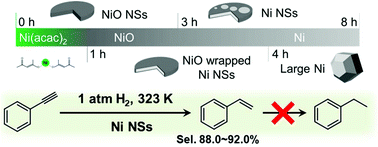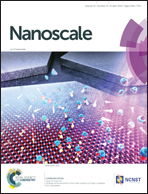Synthesis of ultrathin Ni nanosheets for semihydrogenation of phenylacetylene to styrene under mild conditions†
Abstract
The synthesis of ultrathin metal nanosheets (NSs) attracts broad scientific and technological interest, and it still remains a challenge for non-noble metals like nickel due to their intrinsic cubic symmetry and high surface energy. Herein, we report a NiO intermediated solvothermal method towards the synthesis of ultrathin Ni NSs (thickness < 3 nm) using N,N-dimethylformamide as the solvent and n-butylamine as the shape controlling reagent. The growth of the ultrathin Ni NSs follows an intermediate mechanism which was proved by the results obtained by means of transmission electron microscopy (TEM), X-ray diffraction (XRD), X-ray absorption spectra (XAS) and X-ray photoelectron spectroscopy (XPS). Under solvothermal conditions, the nickel acetylacetonate precursor was first reduced to a NiO NS intermediate, then reduction occurred and NiO NSs were reduced to Ni NSs. The synthesized ultrathin Ni NSs predominately in a metallic state showed high selectivity (88.0–92.0%) towards styrene (ST) in the phenylacetylene (PA) semihydrogenation reaction under mild conditions (323 K, 1 atm of hydrogen) in a broad PA conversion range (2.0–98.0%). The low coverage of oxygen atoms on the Ni NS surface is proposed to account for the high ST selectivity, as indicated by density functional theory (DFT) calculations.



 Please wait while we load your content...
Please wait while we load your content...